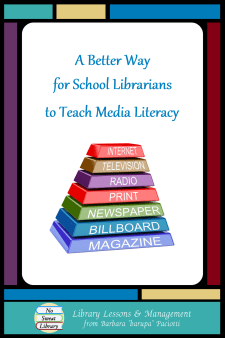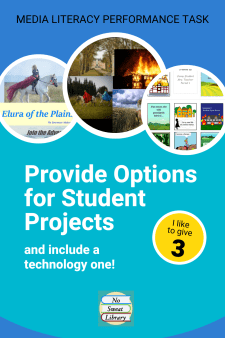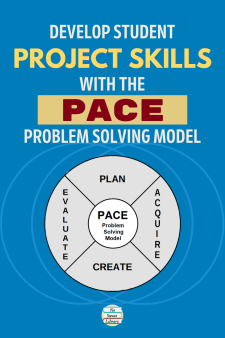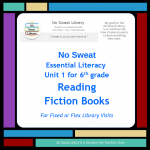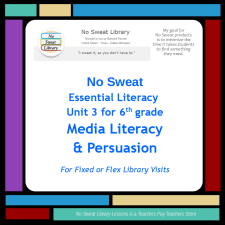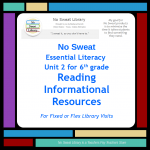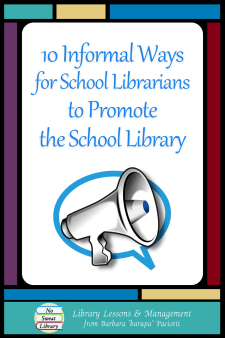 School Librarians are often told to promote their school library program, to push its visibility within the school and out into the community. There are many materials available for library advocacy—from simple activities or events to entire programming kits—that allow us to be continuously alert for ways to connect with folks in the school and the community.
School Librarians are often told to promote their school library program, to push its visibility within the school and out into the community. There are many materials available for library advocacy—from simple activities or events to entire programming kits—that allow us to be continuously alert for ways to connect with folks in the school and the community.
However, after years as a middle school librarian, I’ve found it’s our informal practices that are most effective for building awareness of the school library program. Based on what has worked for me, here are 10 informal ways to advocate for your school library program and promote its value to the school community.
BRING STUDENTS INTO THE SCHOOL LIBRARY
Make the school library the place students need to go to get things done. I always have art materials—markers, poster board, scissors, tape, glue, etc.—in convenient totes so students can come in before, during, or after school to work on projects. The current catch-phrase is “makerspace,” but my students have always associated the library with “making” what they need!
Always have computers turned on, ready for students to use any time of day. I offer a “Tech Morning” once a week for kids to learn about a new app or online service. Believe me, kids love to learn new technology, and when teachers see students asking to use an app for a project, they become interested in learning more technology from me.
I have a variety of games that are fun, yet reinforce learning, such as Scrabble and Monopoly ($$ & math). I also have reading alcoves for students who want a quiet place to read when others are working at tables or on computers. (Our general guideline is that students can converse as long as they use 2-foot voices…a completely silent library is not conducive to collaboration.)
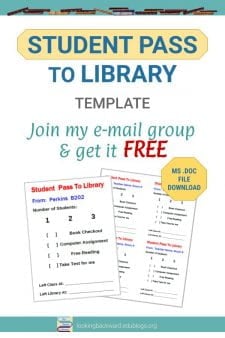 Make it easy for students to come in during down-time in class. Every year I supply a personalized laminated pass for each classroom teacher to fill out with a dry-erase marker allowing students to come to the library if they need a book, computer, whatever.
Make it easy for students to come in during down-time in class. Every year I supply a personalized laminated pass for each classroom teacher to fill out with a dry-erase marker allowing students to come to the library if they need a book, computer, whatever.
Always let students help out. They may ask to shelve books—it may not be perfect, but it gets books back on the shelves and students feel good about helping. Utilize student input and help to create displays for bulletin boards and shelves. Student-created, eye-catching displays inspire kids to come inside.
PROMOTE COLLABORATION WITH CLASSROOM TEACHERS
Teachers have enough on their plate without us adding to it, so approach teachers with a written lesson plan that enhances their current classroom activities. This personalized service shows teachers how easy it is to include us in the lesson planning experience so we can provide quality skills and resources.
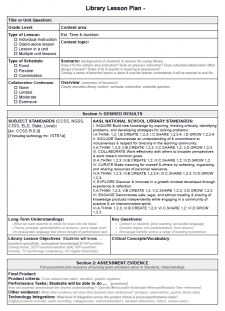 |
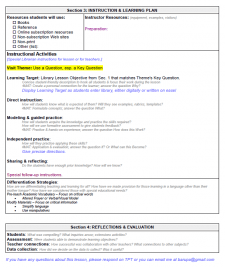 |
(Download my specialized Library Lesson Plan template from the ‘FREE Librarian Resources’ page) |
Make it a professional goal to be familiar with all grade level subject curricula and build the library’s collection and online resources to support that curricula. Colleagues then see us as the curriculum expert in the building and come to us for ways to enhance their classroom activities!
CREATE A FORMAL LIBRARY CURRICULUM
Collaboration is especially difficult if library skills are embedded into course curricula without specifying them as library skills. We then have to convince teachers they really aren’t responsible for teaching those (without actually telling them they don’t know how to do it and we can do it better). In fact, the biggest challenge school librarians face is getting teachers and administrators to realize we are an education professional, trained to teach students the specific information literacy skills so necessary for school, college, and their future in a global digital society.
When there is no written library curriculum, we must create one. It shows our colleagues that we have a curriculum we need to coordinate with their classroom content. To make it easier to integrate information-literacy skills into subject curricula, I created a curriculum matrix where I can track opportunities for library visits and design truly relevant lessons that scaffold info-lit skills across subjects and grade levels.
| Sample No Sweat Curriculum Matrix click to enlarge |
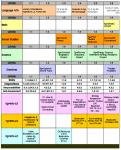 |
You can get my No Sweat Curriculum Matrix from No Sweat Library, my Teachers Pay Teachers store. |
COUNTERACT THE INTERNET’S INFORMATION OVERLOAD
Given the easy access to information through the Internet, every school librarian faces the lack of understanding from colleagues about our role in the school. We must show colleagues that the Web increases the need for a school librarian, and that we have the training to curate and refine information overload. We must continually emphasize that it’s our responsibility to show students how to legally and ethically curate and use online information, images, and other media.
Each month I send a Media Minute email to school staff highlighting digital and online curriculum assets. This very short, one-minute contact shows we are curricula-oriented specialists:
- an upcoming content area library lesson activity
(gives other teachers an idea of what we could do together) - a new teacher resource in the library
(builds a professional area of supportive curriculum materials) - a useful current lesson-related feature on a subscription service
(reminds teachers that these are the best quality information sources for students).
WIN PARENTS OVER TO BECOME LIBRARY ADVOCATES
Getting parental support at the start of the school year is essential. In our school students took a packet of paperwork home on the first day of school. I include a brochure about library services and a bookmark listing online resources with IDs & PWs for home access. I’ve heard that the bookmark is stuck to a lot of refrigerators!
linebreak
A couple times a year I create a Library Newsletter that’s copied on the back of student report cards to tell parents about library activities and supporting resources. It’s also prominently posted on the school library website.
Intermittently I make positive phone calls to parents giving feedback about a particularly memorable thing their child did in the library, especially for those students who often get negative calls home. This makes me a visible and valuable member of the school faculty, and these positive contacts make a world of difference for getting overdue books returned at the end of each semester!
Most importantly, the school’s PTA can be our best supporter, so do favors for, and become good friends with the ladies who run it, since they often have a direct line to the principal’s ear!
CULTIVATE ADMINISTRATIVE SUPPORT
Within the school, the principal is definitely the most influential person when it comes to the school library. Submit regular reports showing both hard & soft data about the library and its activities—and make it colorful so it stands out among all the other paperwork on the principal’s desk! Give copies to the assistant principals and counselors, too…they have more direct contact with students and that increased awareness will often encourage them to send students to the librarian for assistance.
At the district level, the curriculum coordinator can impact school libraries and librarians. You may have a district library coordinator who works with them, but individual librarians can also share information. I include the curriculum coordinator on my Media Minute email list.
I’ve discovered our greatest district advocate is the Public Relations department—they control the public’s perception of the school district and if they are on your side, you are gold. They’ll post pictures of library activities, promote reading programs, and make sure everyone in the community, from parents to businesses, and administration to support staff, is aware of your importance. They can also be instrumental in publicizing fund-raising efforts!
BECOME INDISPENSABLE BEYOND THE LIBRARY
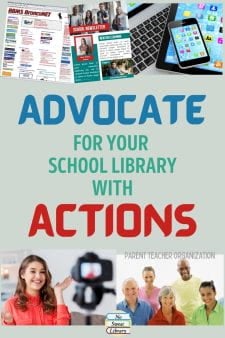 Help folks realize you can do more than checkout and shelve books. Be a troubleshooter and trainer for technology used in the classroom. Volunteer to photograph or videotape student presentations in the classroom. Make the library website an essential part of the school’s web presence.
Help folks realize you can do more than checkout and shelve books. Be a troubleshooter and trainer for technology used in the classroom. Volunteer to photograph or videotape student presentations in the classroom. Make the library website an essential part of the school’s web presence.
Sponsor a school club in the library (chess? school news?). Open a school supply shop during lunches with essentials (pens, pencils, notebook paper) and periodically offer “fru-fru” (feather pens, funny erasers, neon color paper).
In other words, don’t advocate with words about the importance of a school library; advocate with actions to show the importance of having a certified school librarian.
BECOME PART OF THE SCHOOL’S DECISION-MAKING TEAM
Volunteer for any committee that even remotely impacts the library program or the school librarian, especially those that showcase your librarian and personal skills. Nurture ties to subject area department heads so any curriculum-planning activity includes you. Become best friends with your school secretaries, custodians, and cafeteria staff so they view you as an essential member of their team, too. It’s amazing how often the phrase, “Let’s see what the school librarian has to say about this!” shows how vital you are to the school and its mission.
BECOME AN EDUCATIONAL LEADER
One year we got a new principal, and to familiarize himself with the school culture, he set up interviews with staff members during the summer. One question he asked each person was, “If the principal was suddenly gone for some reason, who are 3 people in the school you could rely on to keep things running smoothly?” I was flattered that quite a few folks mentioned me, the school librarian, so I made it my goal that everyone would mention the school librarian in answer to such a question! By encompassing that broad concept I was able to see more possibilities for involvement than listing disparate things I wanted to accomplish.
USE DISCERNMENT WHEN RAISING FUNDS
I’m fortunate that my district supports the library program with substantial funds for books and online resources, so I don’t have to, as so many do, weasel money from a principal or try to raise funds on my own. I am, however, adamant about one way a librarian does NOT raise money: with fines for overdue books.
Fines don’t work. Well-off students don’t care about the paltry amount and poorer kids get stressed trying to pay a fine and still have money for lunch (or dinner on their way home), and basically it just makes a lot more work for the librarian, especially if there’s a whole class trying to check out books in the last 10 minutes of the period.
There are much more effective ways to tease kids into getting overdue books back. And really, it’s just a book and there’s plenty more on the shelves—a child and their feelings are a lot more important than a fine (or even a lost book)!
Well, those are the 10 informal ways I promote our school library program. I hope you find these ideas helpful. Happy advocating!
![]()
This post is updated from 2015.



